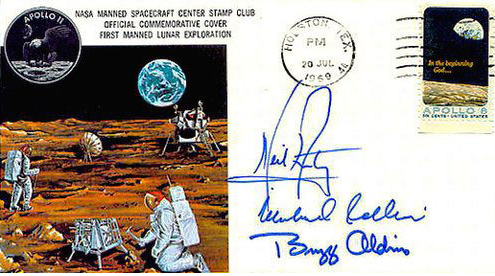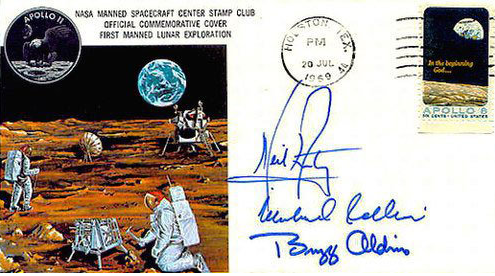Neil Armstrong’s Insurance Policy

When Neil Armstrong, Buzz Aldrin, and Michael Collins boarded Apollo 11 on their way to the moon, they and everyone else knew that there was a good chance that it was going to be a one-way trip. As previously recounted on these pages, President Richard Nixon was prepared to address the world in case Aldrin and Armstrong were marooned on the moon, having a speech at the ready in case that occurred. But Nixon wasn’t alone in worrying about that outcome — so were the astronauts themselves. They wanted to make sure that their families were provided for in case the worst happened, so they went out to buy life insurance.
And what they found was that no one wanted to sell it to them. So, they made their own, kind of.

Pictured above is a commemorative cover — basically an envelope — marking the first manned moon landing. If you look carefully, you’ll note that the stamp has a cancellation mark dated July 20, 1969, which not coincidentally is the same day that Armstrong and Aldrin landed on the moon. But the location of the cancellation mark isn’t “Sea of Tranquility, Moon” but rather the much less exotic address of “Houston, Texas.” That’s important because it means that the cover pictured above never made it to the moon.
That was by design. Armstrong and company realized that they were famous — and, regardless of the success of their mission, were likely going to be even more famous — and their signatures were valuable. This gave them the opportunity to provide for their families in case of disaster. As NPR reported, before leaving Earth, the three astronauts signed hundreds of these covers and asked a trusted friend to hold onto them. And, NPR continued, “on important days — the day of the launch, the day the astronauts landed on the moon — their friend got [the covers] to the post office and got them postmarked, and then distributed them to the astronauts’ families.” A commemorative cover, signed by all three and cancelled on the date of the lunar landing (and cancelled around the block from mission control at that), would be worth a good amount of money if the threesome failed to return to Earth.
Thankfully, it didn’t come to that, and the families never needed to sell off what are now known as “insurance covers.” But they didn’t throw them out, either. On occasion, collectors can still find them at auction — but they can run as much as $8,000.
Bonus fact: While Neil Armstrong is now a household name, his fame from the first lunar lander was fleeting. Per the book “No Requiem for the Space Age” (relayed by NPR’s Robert Krulwich), even a year after the moon landing, many Americans had trouble recalling Armstrong’s name. Per Krulwich, “when the [Philadelphia Sun] Bulletin asked its readers in 1970 to name the first man on the moon, the guy who said, ‘One giant step for man … ,’ 70 percent of Philadelphians didn’t know.” Similar results came in from across the country. As the lunar missions moved from the newspapers to the history textbooks, though, more and more people learned and re-learned Armstrong’s name. (Here’s a neat graph showing the uptick of his name in books starting in about 1984.)
From the Archives: Space Mail: Why the Apollo 15 crew took mail to the moon, and why they got in trouble for it.
Take the Quiz: Name the astronauts who have walked on the moon.
Related: “No Requiem for the Space Age” by Matthew D. Tribbe. Mixed reviews. Or, an Apollo 15 insurance cover. (At the time of this writing, Amazon didn’t have any Apollo 11 ones listed.) It’s neat, but it’ll run you about $1,000.
